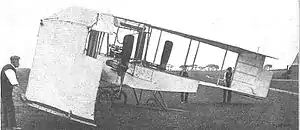Dunne D.5
The Dunne D.5 was an experimental aircraft built in the United Kingdom in 1910. Designed by J. W. Dunne and built by Short Brothers at Leysdown,[1][2] A tailless swept-wing biplane, the D.5 was the first aircraft built by his company, the Blair Atholl Aeroplane Syndicate Ltd. Like its military predecessors it was driven by twin pusher propellers, but it had a considerably more powerful engine.
| D.5 | |
|---|---|
 | |
| Role | Experimental aircraft |
| Manufacturer | Short Brothers |
| Designer | J. W. Dunne |
| First flight | 1910 |
| Number built | 1 |
| Developed from | Dunne D.4 |
| Developed into | Dunne D.8 |
The D.5 first flew in the summer of 1910, Dunne having long ago literally dreamed of this flight. The D.5 was later certified as the first fixed-wing aircraft ever to achieve stability in flight, one of the official witnesses being Orville Wright.
Development
On leaving the Army Balloon Factory at Farnborough in 1909, J. W. Dunne set up a company, the Blair Atholl Aeroplane Syndicate Ltd., to continue developing his aircraft, none of which had yet flown under power. The D.5 was their first aircraft and it followed the basic design of the earlier D.1B and D.4 Army machines in having a tailless, swept biplane wing with pronounced wash-out. Like the others it was also driven by twin pusher propellers. However it differed in having a streamlined central nacelle or fuselage housing the pilot and engine, and the engine itself was a more powerful Green four-cylinder inline type.
The controls were also unusual. Elevons at the wing tips provided all the control forces and were operated by two levers on either side of the cockpit. There was no rudder, with turning being coordinated by the aerodynamic design of the swept and washed-out wings. Endplate fins were fitted to the wings, to improve efficiency.
Construction of the main airframe was contracted to Short Brothers.
Operational history
Following construction at Leysdown, the D.5 was taken to Eastchurch, the new site of the (now Royal) Aero Club and the Syndicate. Early trials were not encouraging, with the machine in its original form proving too heavy.
The D.5 first flew, piloted by Dunne himself, in the summer of 1910. Dunne taxied to the top of a rise in the ground which lay downwind, turned the machine and took off downhill and into the wind. Dunne later recalled in his book An Experiment with Time that, as a child, he had experienced exactly this flight in a dream.[3]
The D.5 proved to be aerodynamically stable in flight. Two demonstration flights were made for the Royal Aero Club in December 1910, officially witnessed by the visiting Orville Wright and by Griffith Brewer. During the second flight, Dunne took his hands off the controls for an extended period, while he wrote a note on a piece of paper provided for him by Brewer. This note was the first ever documentary evidence of an aircraft's performance written in flight by the pilot himself.[3][4] The D.5 was subsequently certified as the first fixed-wing aircraft ever to achieve stable flight.
Specifications

General characteristics
- Crew: One pilot
- Length: 20 ft 5 in (6.21 m)
- Wingspan: 46 ft 0 in (14.02 m)
- Height: 11 ft 6 in (3.51 m)
- Wing area: 527 sq ft (49.0 m2)
- Gross weight: 1,550 lb (703 kg)
- Powerplant: 1 × Green , 60 hp (45 kW)
Performance
- Maximum speed: 45 mph (72 km/h, 39 kn)
References
| Wikimedia Commons has media related to Dunne D.5. |
- Notes
- Barnes C.H. & James D.N. Shorts Aircraft since 1900. London (1989): Putnam. pp. 50, 439. ISBN 0-85177-819-4.CS1 maint: location (link)
- "The Dunne Aeroplane". Flight: 459–61. 18 June 1910. Retrieved 27 February 2008.
- Constance Babington Smith; Testing Time, Pages 11-17.
- Poulsen, C. M. (27 May 1943). "Tailless Trials". Flight: 556–58. Retrieved 27 February 2008.
- Bibliography
- Taylor, Michael J. H. (1989). Jane's Encyclopedia of Aviation. London: Studio Editions. p. 347. ISBN 0-7106-0710-5.
- Munson, Kenneth (1969). Pioneer Aircraft 1903-14. London: Macmillan. p. 44.